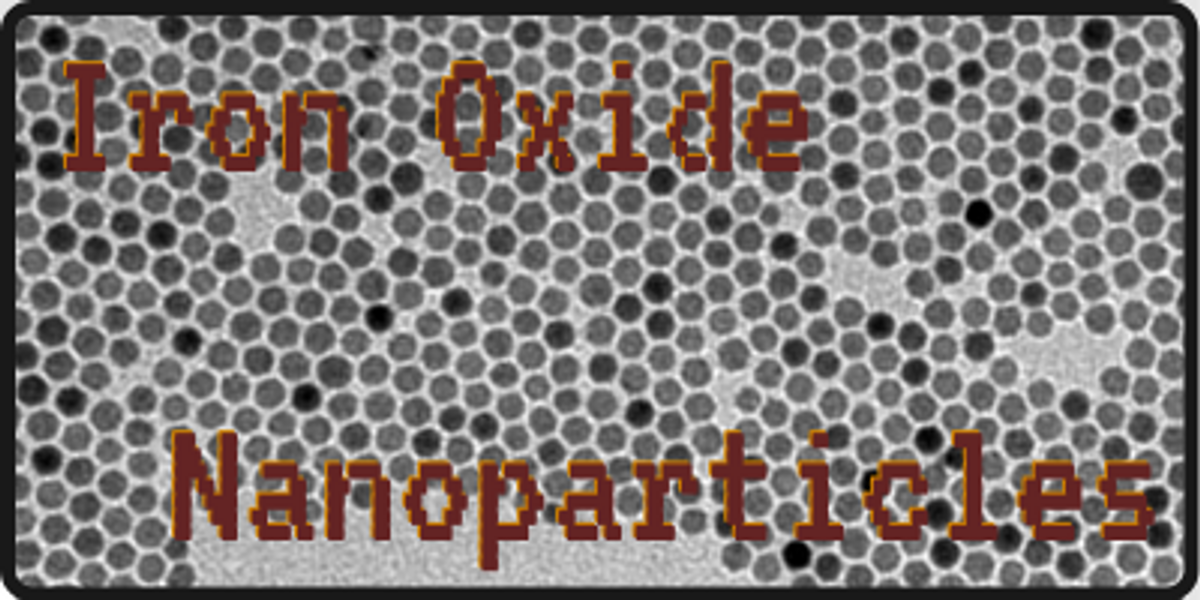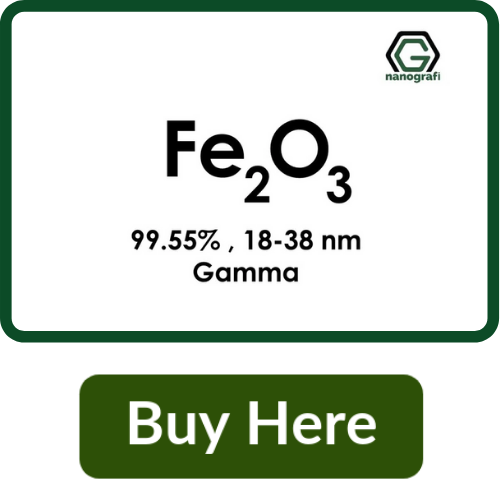Iron Oxide Nanoparticles/Nanopowder and Applications
Iron oxide nanoparticles/nanopowder are nanoscale crystals of iron oxide (g-Fe2O3, α-Fe2O3 and Fe3O4) with a considerably great surface area and surface-to-volume ratio. Iron oxide has a unique superparamagnetic property with an easy separation method.
Considering their physical and chemical specifications, iron oxide nanoparticles have biomedical, environmental and agricultural applications. Iron oxide nanoparticles/nanopowder are advantageous as they can be modified by organic and inorganic agents, antibodies, nonionic detergents, starches, enzymes, proteins, drugs, nucleotides and polyelectrolytes for further applications based on their wide surface chemistry potentials. As the most common magnetic nanoparticle, iron oxide nanoparticles can be employed in organs, tumors and tissues by applying an external magnetic field for hyperthermic treatment purposes 1.
Iron Oxide
Iron oxide is the product of a chemical reaction between iron (III) and oxygen. In general, nearly as many as 16 different iron oxides occur naturally with g-Fe2O3 (maghemite), α-Fe2O3 (hematite) and Fe3O4 (magnetite) as the most common ones. Since they are inexpensive and prevalent, iron oxides have extensive applications and emerge as important agents in many geological and biological processes and are applied as catalysts, pigments and as ores as well 2. The three above-mentioned iron oxides are important scientifically and technologically as well. The versatility of iron oxides has inspired researchers to focus on their nanoscale crystals and powder which are even more versatile due to their remarkable surface chemistry achieved there. The research has proved that nanoparticles made of materials with ferromagnetic properties sized smaller than 20nm show unique form of magnetism including superparamagnetism. Oxides and alloys are among the ferromagnetic compounds which become magnetic when an external magnetic field is applied. This comes up as a favorable property when the mentioned materials fit in nanoscales. Magnetic iron oxides (g-Fe2O3 and Fe3O4) have focused attention on their nanoscale particles because of their low toxicity superparamagnetic properties and simple separation with applications in medical diagnostics as magnetic resonance imaging (MRI) protein immobilization in biomedicine, drug delivery and thermal therapy. In macroscopic applications, the reactivity of iron is crucial, however, in nanoscales, it causes concerns as it adopts pyrophoric behavior meaning it ignites spontaneously in the air. It is practically easy to induce iron nanoparticles into magnetic resonance through applying the external magnetic field and self-heating1.
Check our other Nanoparticle Articles
Synthesis of Iron Nanoparticles
Several methods have been suggested for the synthesis of iron nanoparticles namely dry processes, microbiological techniques and wet chemistry. Generally, the synthesis methods can be categorized as physical, chemical and biological methods. In the physical method of iron oxide nanoparticle synthesis, the top-down technique is adopted to breakdown the bulky crystals into smaller ones. Nevertheless, the control over the particles size and homogeneity is lost and some particles get sizes that don’t fit in the nanoscales. Some of the physical techniques are laser ablation, ultraviolet irradiation, lithography, ultrasonic fields and aerosol technologies. The chemical synthesis methods are considered the best and most efficient with higher uniformity of particles in nanoscales. These methods are simple and tractable through which the particles shape and composition can be controlled so precisely. Amongst, liquid phase methods, two-phase methods (microemulsion), sol–gel method, gas/aerosol phase method, polyols method, hydrothermal reaction methods and sonolysis are the methods with favorable products. Briefly, the iron oxide nanoparticles are prepared through coprecipitation reaction of Fe2+ and Fe3+ through adding a base. The type of the iron slat used in the synthesis process, ionic strength, pH and the Fe2+/Fe3+ ratio determine the composition, shape and size of the resulting nanoparticles. The biological method of iron oxide nanoparticles synthesis is also advantageous as it fits well in the green chemistry promises through using microbes, bacteria, viruses and fungi in the synthesis process. Such biological methods include intracellular synthesis of nanoparticles by bacteria, extracellular synthesis of nanoparticles by bacteria, biosynthesis of nanoparticles by fungi, intracellular synthesis of nanoparticles by fungi, actinomycete mediated synthesis of nanoparticles, yeast mediated synthesis of nanoparticles and virus mediated biosynthesis of nanoparticles 31.
Surface Modification of Iron Oxide Nanoparticles
With all the advantageous of iron oxide nanoparticles, they suffer from agglomeration when they are left unmodified mainly because of their high-energy surface, van der Waals forces and strong magnetic power. In addition to this, higher concentration of Fe2+ and Fe3+ is considered toxic for organism. However, if the surface of the nanoparticles is modified or functionalized, it is easy to get over these consequences. Modification and functionalization increase the compatibility of the iron oxide nanoparticles and creates hydrophilicity on their surface. Therefore, a careful and smart surface modification strategy can increase the selectivity in delivering a given drug or agent to a particular organ and more importantly, make the iron oxide nanoparticles biocompatible and nontoxic. Following the necessities mentioned above, there have been a lot of efforts towards coating and modifying the iron oxide nanoparticles/ nanoparticles/nanopowder. In biomedical application, the modification is according on the application. It has been found out that proteins, enzymes, antibodies, nucleotides and drugs can bind to magnetic iron oxide nanoparticles. There are reports of coating iron oxide nanoparticles with biomolecules such as lactobiotonic acid, gluconic acid and polyacrylic acid with the resulting homogenous particle size distribution and hydrophilic properties for uses in tissue engineering and liposome coating 1.
Important Factors to Enhance the Efficiency of Iron Oxide Nanoparticles
First of all, chemical precipitation is regarded as the cheapest, simplest and the most effective way to synthesize magnetic iron oxide nanoparticles. Next, the use of economical initial reagents and chemicals can lead to cost-effective final iron oxide nanoparticles for applications in less sensitive purposes. Later, the small size of iron oxide nanoparticles results in high surface area to volume ratio enabling interactions with distinct chemical specious as aqueous and gaseous ones. Finally, it is possible to activate iron oxide nanoparticles through altering the particle shape to make the catalytic site more available. Therefore, reproducible, scalable, durable and dispersible particles with controlled growth, shape and nucleation are significant 1.
Iron Oxide Nanoparticles Applications
Taking the advantage of their magnetic properties, iron oxide nanoparticles/nanopowder are widely used in biology and medicine mostly for separating biological products magnetically and delivering the particles to specific sites in drug delivery applications. Clinical applications of iron oxide nanoparticles as magnetic carries play an important role in diagnostics. In labeling materials in life science iron oxide nanoparticles appear to be so versatile and effective. Moreover, there are numerous reports on the use of iron oxide nanoparticles in fields like environmental remediation, food and agriculture, health care, energy, defense and aerospace technology, construction, textiles, automotive and electronics.
There have been continuous progress and evolution in the quality, sensitivity, selectivity and versatility of iron oxides nanoparticles/nanopowder since their introduction to science and industry. The bare iron oxide nanoparticles/nanopowder might not be specific for sensitive applications. As a result, modification and coating strategies are so useful to improve the quality, sensitivity and, etc. There are ongoing and facile efforts to prepare monodispersed spherical iron oxides nanoparticles/nanopowder with particular shape, size and magnetic properties.
References
1. Zia, M., Phull, A. R. & Ali, J. S. challenges of iron oxide nanoparticles. 49–67 (2016).
2. Schwertmann, U. 1 Introduction to the iron oxides.
3. Narayanan, K. B. & Sakthivel, N. Biological synthesis of metal nanoparticles by microbes. Adv. Colloid Interface Sci. 156, 1–13 (2010).
Recent Posts
-
Turning Noise into Power: Energy Harvesting with Piezoelectric Nanogenerators
Ambient acoustic energy, once an untapped resource, is now being converted into sustainable electric …5th Mar 2025 -
Holey Super Graphene in Li-ion Batteries: Next Generation of Energy Storage
Holey Super Graphene (hG), also referred to as “holey graphene,” is redefining li-ion ba …7th Feb 2025 -
Future Communication with 5G Technology and Advanced Materials
5G technology opens the doors to a new era in communication with faster connection speeds, low laten …6th Feb 2025













